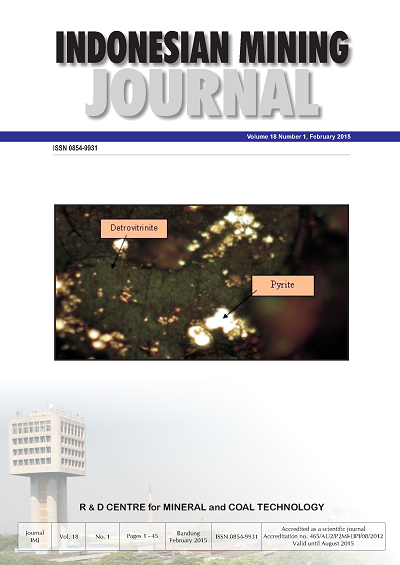BIOSOLUBILIZATION OF PHOSPHATE ROCK BY Penicillium sp
DOI:
https://doi.org/10.30556/imj.Vol18.No1.2015.304Keywords:
phosphate rock, biosolubization, Penicillium sp, oxalic acid, citric acidAbstract
Phosphorus is an essential element that regulates soil fertility. Its deficiency is replenished by chemical fertilizer made from phosphate rock. An environmentally friendly and economically alternative to chemical processing of phosphate rock is the use of phosphate solubilizing microorganisms. In this research, a potential phosphate solubilizing fungi were successfully isolated from the surface of Cijulang phosphate rock and identified as close relative of Penicillium sp. The phosphate biosolubilization capability of the fungus was tested and the influence of leaching parameters such as particle size of mineral, ore concentration (pulp density), and initial pH of medium was investigated using a shake flask study to characterize the solubilization of phosphorus by Penicillium sp. The x-ray diffraction data indicated the presence of hydroxyl apatite Ca5(PO4,CO3)3OH as the main source of phosphorus.The fungal strains of Penicillium sp produced oxalic and citric acids during fermentation of glucose which resulted in a drop pH of the growth medium. The results also indicated a potential relationship between the phosphorus biosolubilization and the production of organic acids by the fungus. In addition, particle size, ore concentration and initial pH were also shown to have significant effects on the solubilization of phosphorus from the phosphate rock. The optimal speed of attack was obtained for a surface area of substrate of .-200 mesh. A concentration of 5% solid gave the highest speed of P biosolubilization. The optimum range of initial pH was 6-7 and initial pH began to show an inhibiting effect at 4. The maximum percentage of soluble phosphorus released of 42.8% was attained using -200 mesh particle size, 5% pulp density and initial pH 6 after 16 days of process.
References
Adeleke, R., Cloete, E., and Khasa, D., 2010. Isolation and identification of iron-solubilising fungus. Online South African Journal of Science 9-10, published October 2010.
Ambreen, N., Bhatti, H.N., and Bhatti, T.M., 2002. Bi- oleaching of bauxite by Penicillium simplicissimum. Journal of Biological Science, 2 (12), p. 793-796.
Antoun, H. and Babana, A.H., 2006. Effect of Tilemsi phosphate rock-solubilizing microorganisms on phosphorus uptake and yield of field-grown wheat (Triticum aestivum L.) in Mali. J Plant Soil, 287, p. 51-58.
Ashraf, M., Zafar, Z.I., and Ansari, T.M., 2007. Selec- tive leaching of low grade calcareous phosphate rock in succinic acid. Journal of Research Science, Bahauddin Zakariya University, vol. 16, no.2, p. 145-157.
Bhattacharya, S.S., Barman, S., Ghost, R., Duary, R.K., Goswami, L., and Mandal, N.C., 2013. Phosphate solubilizing ability of Emericella nidulans strain V1 isolated from vermicompost. Indian Journal of Experimental Biology, vol. 51, p. 840-848.
Castro, I.M., Fietto, J.L.R., Vierra, R.X., Tropia, M.J.M., Campos, L.M.M., Fanigo, E.B., and Brandao, R.L., 2000. Bioleaching of zinc and nickel from silicate using Aspergillus niger cultures. Hydrometallurgy, vol. 57. p. 39-49.
Chandraprabha, M.N. and Natarajan, K.A., 2010. Microbially induced mineral beneficiation. Miner. Process. Extr. Metall. Rev, 31, p. 1-29.
Chen, C.R., Condron, L.M., and Xu, Z.H., 2008. Impacts of grassland afforestation with coniferous trees on soil phosphorous dinamics and associated microbial processes: a review. Forest Ecol Manag. 255, p. 396-409.
Elser, J.J., Bracken, M.E.S., Cleland, E.E., Gruner, D.S., Harpole, W.S., Hillebrand, H., Ngai, J., Seabloom, T.E.W., Shurin, J.B., and Smith, J.E., 2007. Global analysis of nitrogen and phosphorus limitation of primary producers. Ecol. Lett. 10, p. 1135-1142.
Habashi, F., 2014. Chemical beneficiation of phosphate rock. E&MJ Engineering and Mining Online Jour- nal, published October 17, 2014.
Hamdali, H., Hafidi, M., Virolle, M.J., and Ouhdouch, Y., 2008. Rock phosphate solubilizing actino- mycetes: Screening for plant growth promoting activities. World Journal Microbiol Biotechnol, 24, p. 2565-2575.
Handayani, S., Wahyudi, T., and Suratman, 2009. Studi bioleaching batuan fosfat menggunakan jamur Aspergillus niger. Jurnal Teknologi Mineral dan Batubara, vol. 5 no. 4. Oktober, p. 183-190.
Jain, N. and Sharma, D., 2008. Byohydrometallurgy for non sulfidic minerals-A review. Geomicrobiology Journal 2 (3), p. 135-144.
Modak, J.M., Vasan, S.S., and Natarajan K.A., 2001. Calcium removal from bauxite using Paenibacil- lus polymyxa. In: Kawatra S.K, Natarajan K.A., (editors), Mineral biotechnology: microbial aspects of mineral beneficiation, metal extraction, and environmental control. United States of America: Society for mining, metallurgy, and exploration, p. 13-25.
Saeed, S., Bhatti, H.N., and Bhatti, T.M., 2002. Bi- oleaching studies of rock phosphate using Asper- gillus niger. Journal of Biological science 2 (2), p. 76-78.
Sharma, K., 2011. Phosphate solubilization potential of Penicillium species inhabiting the Hilly Terrains of Pachmarhi (India). Oriental Journal of Chemistry, vol. 27, no. 1, p. 101-103.
Ullah, I., Jilani, G., Khan, K.S., Akhtar, M.S., and Rasheed, M., 2013. Phosphorus solubilization from phosphate rock by the interactive effect of Thioba- cilli and elemental sulfur. J. Agric, Resources 51 (4), p. 431-442.
Vassilev, N., Medina, A., Azcon, R., and Vassileva, M., 2006. Microbial solubilization of roch phosphate on media containing agro-industrial wastes and effect of the resulting products on plant growth and P uptake. J. Plant Soil 287, p.77-84.
www.iranreview.org. January, 10, 2009. Iranian inventor produces bioleaching phosphate fertilizer.
Willscher, S., and Bosecker, K., 2003. Studies on the leaching behaviour of heterotrophic microorgan- isms isolated from an alkaline sludge dump. Hy- drometallurgy 71, p. 257-264.
Xiao, C., Chi, R., He, H., and Zhang, W., 2009a. Char- acterization of tricalcium phosphate solubilization by Stenotrophomonas maltophilia YC isolated from phosphate mines. Journal of Central South University of Technology, 16(4), p. 581-587.
Xiao, C.Q., Chi, R.A., He, H., Qiu, G.Z., Wang, D.Z., and Zhang, X.W., 2009b. Isolation of phosphate- solubilizing fungi from phosphate mines and their effect on wheat seedling growth. J. Appl Biochem Biotechnol, 159, p. 330-342.
Yasser, M.M., Mousa, A.S.M., Massoud, O.N., and Nasr, S.H., 2014. Solubilization of inorganic phos- phate by phosphate solubilizing fungi isolated from Egyptian soils. Journal of Biology and Earth Sciences, vol. 4, no.1., p. 83-90.
Downloads
Issue
Section
License
Indonesian Mining Journal provides immediate open access to its content on the principle that making research freely available to the public to supports a greater global exchange of knowledge.

This work is licensed under a Creative Commons Attribution-NonCommercial 4.0 International License.













